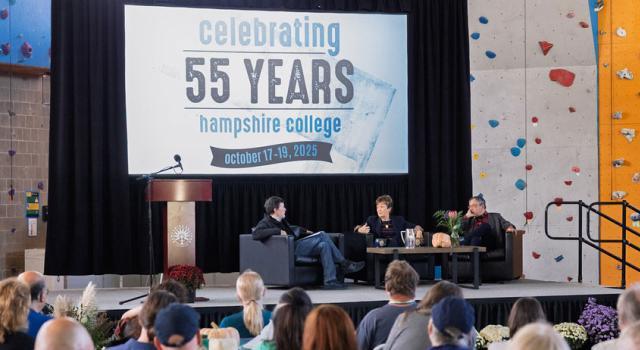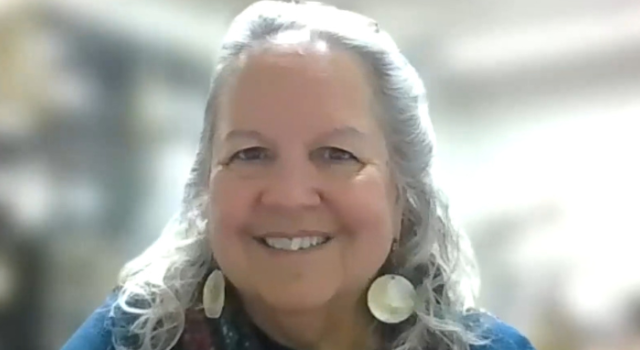Spring Learning Collaborative Symposium Explores the Future of Art Making for Social Good
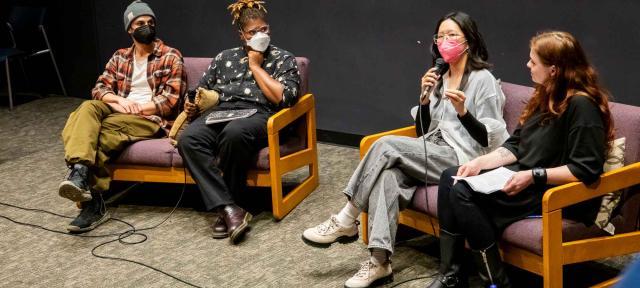
On March 14, Hampshire held its second Learning Collaborative Symposium, “Speculative Praxis,” a panel discussion on what art making can offer us as we imagine futures that are humanizing, life-affirming, and liberating.
The symposium took place in Franklin Patterson Hall in front of an enthusiastic crowd of students, staff, and faculty. The event was free and open to the public.
The Learning Collaboratives (LCs) were created in 2019 and have since been improved by cross-constituency working groups of students, staff, and faculty. Each LC serves as an affinity group and space of transdisciplinary relationship-building, giving participants opportunities to connect through various social and academic events, both formal and informal.
There are four LCs, each based on an “urgent challenge question” — a globally relevant and timely issue — addressed through a multitude of academic disciplines. Beginning last fall, two LCs have teamed up each semester to organize a symposium with a central theme addressing both of their urgent questions. This semester, Time & Narrative collaborated with Media & Technology to create “Speculative Praxis.” Their challenge questions were How can art and creative practice engage trauma? and What constitutes truth in a post-truth era?
The symposium featured three artists/scholars/organizers with art practices that draw from uplifting elements of their disciplines’ traditions while innovating modes of creation and expression. Reuben Telushkin 08F, an Afro-Jewish audiovisual artist and researcher, works at the intersection of sequential art, sound, motion graphics, and sculpture; JD Stokely 07F creates and curates work about Black queer aesthetics, collectivity, and public spaces; and Lily Xie is a Chinese American artist and educator whose socially engaged work explores desire, memory, and self-actualization for communities of color, largely through animation.
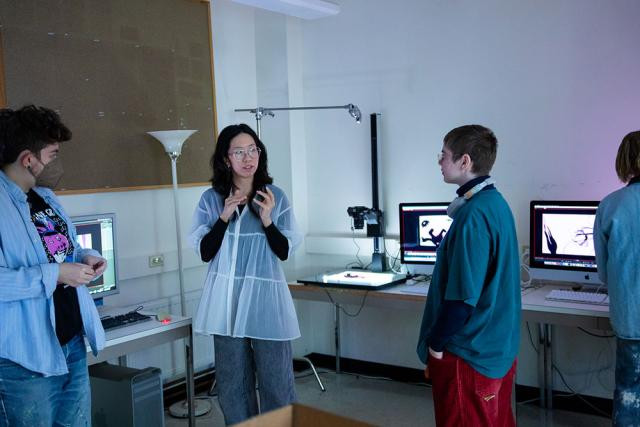
Before the symposium, guests led workshops in their respective disciplines, giving students an opportunity to engage the panelists’ philosophies through hands-on art making. At the symposium, each guest gave a presentation followed by a discussion facilitated by Assistant Professor of Animation, Creative Arts, and Visual Culture Sarah E. Jenkins.
Professor Jenkins opened the symposium by defining its goal as dreaming of new ways in which we can enact change. Calling for the imaginative, participatory acts necessary to affect our future, Jenkins set the tone for what would be a profoundly spiritually rooted panel by quoting from Octavia Butler’s Earthseed series: “All that you touch you change. All that you change changes you. The only lasting truth is change. God is change.” And then, from the theologian Tamisha A. Tyler, reflecting on the text, Butler’s God “is not one to be worshiped, but to be shaped. . . . We do not wait for God to do something. We act. We shape.”
Telushkin discussed the evolution of his art practice while describing its spiritual underpinnings, from his time as a Hampshire student to his current pursuit of an M.F.A. in 4-D design at Cranbrook Academy of Art, in Detroit. His work, sometimes sculptural, sometimes digital, explores feedback loops, cybernetics, fractals, and “sacred geometry,” such as the Fibonacci sequence, a mathematical pattern that can be found everywhere, from sea shells to galaxies.
He draws also from traditional folk symbols, such as the West African Kongo cosmogram, a circular diagram that presents life and death as part of a cyclical system of renewal; the Ghanaian Sankofa bird, which turns its head to the past while pointing its feet toward the present; and the Hebrew Torah scroll, which inspired recent work — a kinetic, looping sculpture.
Telushkin discussed returning to his art after he put it on pause for a number of years to pursue organizing work for justice in Palestine with Jewish Voice for Peace. Whereas he recognizes that sometimes an internal motivational pendulum swings between art and organizing, he says, “they are a part of the same ecosystem.”
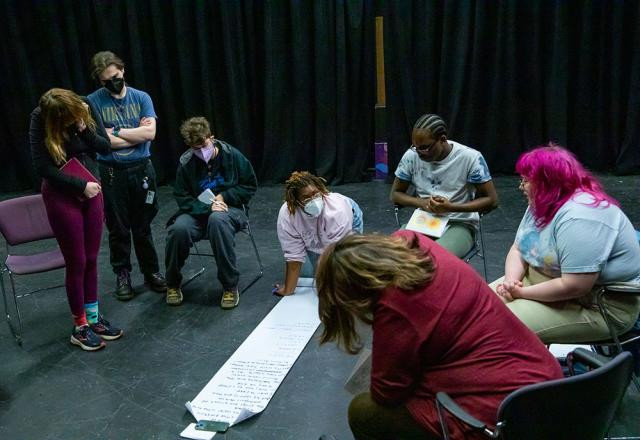
Hampshire alum and James Baldwin Scholar Stokely, who is a Ph.D. candidate at Brown, explored the trajectory of some of their recent work, which is based in theater and explores “Black queer performance and aesthetics, racial ecologies, collective ritual, memory, and public space.” They are a cofounding member of the Unbound Bodies Collective, a Boston-based Black and Latine, queer- and trans-led team that has curated group work, hosted film festivals and workshops, and made an array of public art.
Stokely talked about their recent “living altars” project, “rooted in social justice, that explores, honors, and amplifies the lives of queer Black elders and Black trans/nonbinary artists and activists in the greater Boston area.” They created public installations throughout the city celebrating the history, memory, and dreams of a still living elder/icon they collaborated with, turning mundane spaces, such as a park bench, into living altars.
Quoting from Cruising Utopia, by José Esteban Muñoz, Stokely said, “The here and now is simply not enough,” and that we must engage in speculative praxis to create the emancipatory world of our dreams.
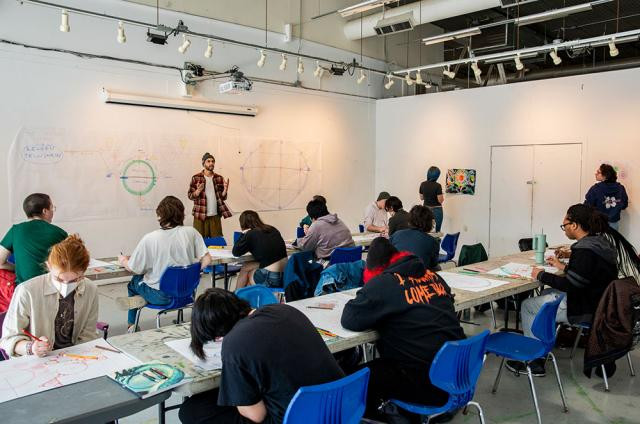
Xie described their journey as an artist, from exchanging zines in basement galleries, to participating in community centering public art, to animation for social justice. Much of their activist work involves housing needs in Boston, especially in Chinatown.
Various developers seeking “community engagement” asked citizens to fill out comment cards on upcoming development projects, they said, only to then seemingly ignore the solicited suggestions. Xie said they “wanted to see what it would take to move away from ‘community engagement’ and toward ‘community power.’”
One such opportunity presented itself while Xie was an artist-in-residence for Boston, working with the Boston Planning and Development Agency (BPDA) as it worked to dissolve itself per the directive of the mayor, who sees it as detrimental to affordable housing. Xie asked community members in and around Chinatown to articulate their visions for the future, and then brought them to life through animation.
In the project’s artist statement, Xie writes, “[B]eyond being a thought exercise, opening a channel for the public to speculate on the future of planning in this pivotal moment [the piece] challenges the Agency to deepen their own imagination by experiencing a portal into a more life-affirming future.” The medium of animation helps Xie think in this way: “Animation is a transformative process where you draw every step along the way,” they said; you enact and create the future you are envisioning.
The panel concluded with a Q&A led by Jenkins, during which the panelists reflected on individuality and its intersections with collectivism and collaboration, as well as their spiritual practice of believing in possible just futures.


